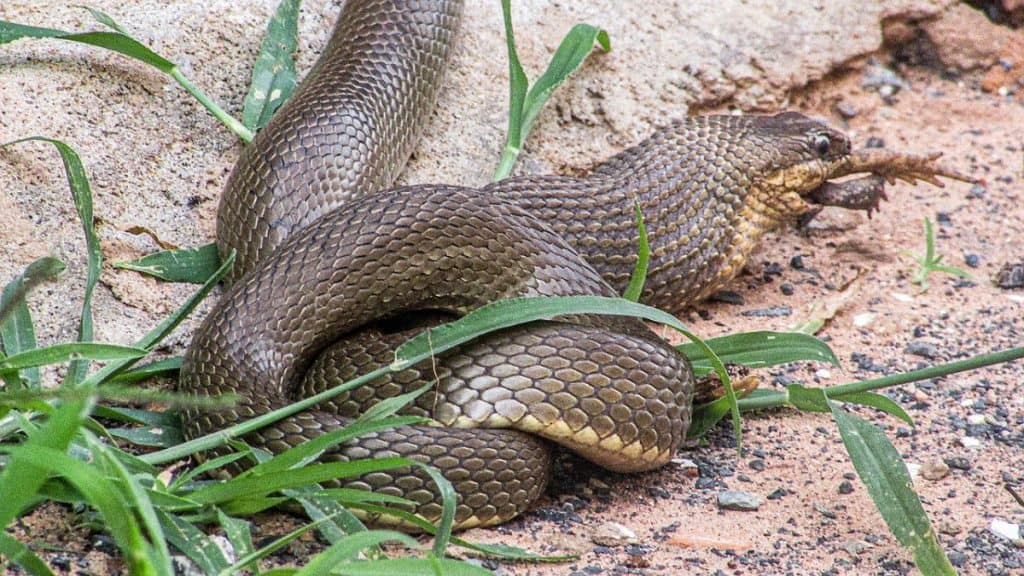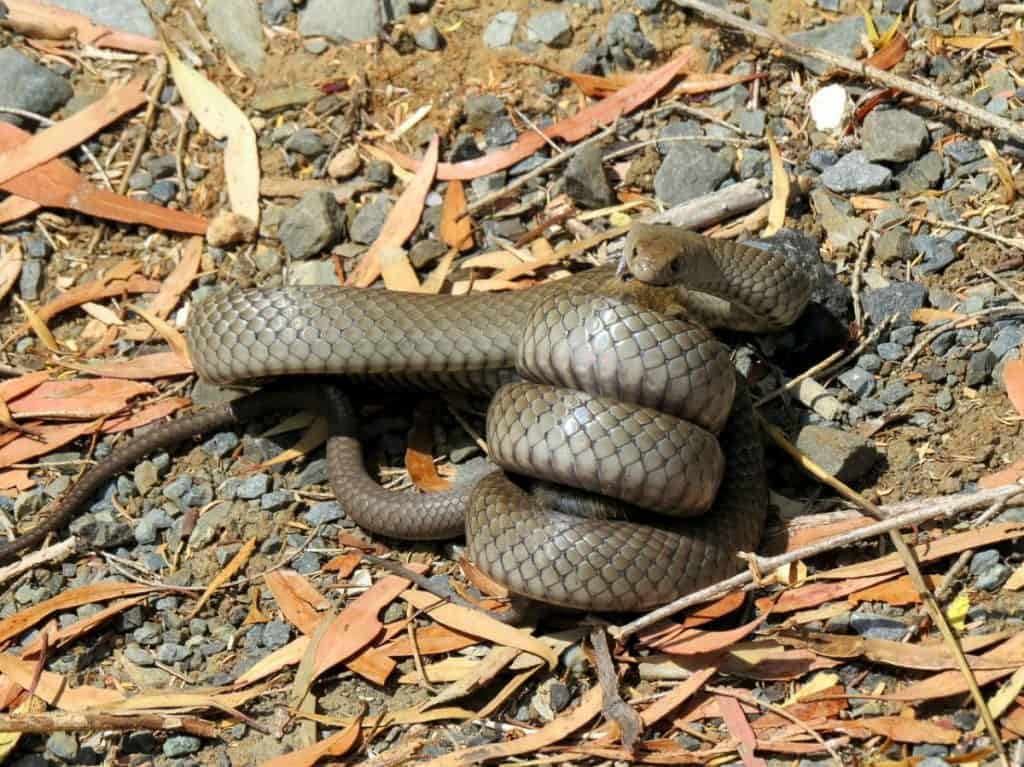Different snakes eat different food, and they hunt in various ways depending on their species. There are over 3,000 species of snakes in the world, and their hunting methods are varied.
Snakes such as constrictors and pythons use their muscles to squeeze their prey, constricting until their prey is dead. Venomous snakes deliver their venom through fangs, found in different parts of the mouth, depending on the species. Many snakes also eat their prey whole.
Snakes hunt in various ways depending on the species, size, and where they live. Some eat a specialised diet, while others eat a wide variety of food. Because snakes move slowly and don’t get the chance to eat often, they have to make the most of each catch. Some species can go for months without eating as their body works at a slow pace.
Do you know how many families of snakes exist? Find out here

How snakes use their senses to catch prey
Snakes can touch, taste, smell, see and hear as most other animals can, but they also have different ways to find out information about their environment.
Different snakes use different senses to catch their prey. Most snakes will use their eyes to follow the movement of their prey. Snakes such as the green whipsnake can be seen following frogs, moving when they hop and stopping when the frog stops.
Snakes that use their eyes as their primary source have large eyes and big, round pupils. Snakes that go out during sunlight hours often have amber-coloured lenses to protect them from the light. Most snakes, however, have small eyes, and many have limited eyesight. Some snakes can only distinguish between light and dark. Snakes don’t have eyelids but have a transparent window called the brille.
However, some, such as tree-dwelling snakes and those active during the day, have excellent vision, although they see movement more than shape or form. Nocturnal snakes have elliptical cat-like eyes that open wide during low light.
Snakes don’t use their ears to find food, except for burrowing snakes that may hear their prey scraping in the earth. Snakes don’t have external ears and only have earbone, which is attached to the jaw. Snakes can only hear low frequencies, so the squeak of a mouse may be outside their hearing range.
Snakes use their tongues to compensate for impaired hearing. Snakes can often be seen flicking out their tongues, waving them in the air or touching the ground. The tongue picks up chemical signals from the air or the ground, and the chemical molecules are brought back into the mouth and inserted onto the vomeronasal organ in the roof of the mouth. This is very similar to what elephants do with their trunks.
The vomeronasal or Jacobson’s organ analyses the chemical signals and allows the snake to track their prey, find a mate, or recognise a nearby predator.
Some snakes can detect infrared radiation, while others rely on their sense of taste and smell. Pit vipers and many boas and pythons all use infrared heat rays. These can be on the side of the face in most pit vipers or many pythons’ lips.
These are the most sensitive heat receptors in the animal world, and they can sense an object differing in temperature from its surroundings by direction and distance. These are so sensitive that they can detect less than 0.001 Celsius changes in temperature.
If you want to know how snakes eat their prey, I have written an article here
What do snakes eat?
All snakes eat other animals, and there are no herbivorous snakes. Snakes have a varied diet depending on their species. Some feed on small mammals, birds, insects, reptiles, amphibians, eggs, and other snakes.
Birds and mammals are their usual prey of snakes that use venom, while animals that constrict their prey eat larger mammals.
Rat snakes climb trees, searching for eggs, squirrels, or baby birds. Tentacled snakes are aquatic snakes that live on a diet of fish. They hide in the plants in the water and grab fish as they swim past. The annulated sea snake feeds on the eggs of various fishes, along with other marine invertebrates and small fish.
The Australasian death adder has an excellent adaptation to help them catch their food. Their tail looks like a worm, and when they wriggle their tail, lizards, birds, and small mammals try to catch them but instead become the prey.
Some snakes feed on eggs. The African egg-eater snake, as its name suggests, eats eggs. They swallow the egg whole, but before this, they taste it with their tongue to make sure it is fresh. Once they have consumed it whole, the neck vertebrae use pointed ends in the oesophagus to crack the eggshell. It then coughs up the remains of the shell, saving room in the stomach.
Some snakes will eat other snakes as part of their diet. The smooth snake will regularly feed on asp vipers. Because of their shape, snakes are easier to eat than a lot of their other prey. The American green snake will feed on grasshoppers, caterpillars, and termites, while thread snakes eat ants and larvae.
Some snakes will only eat frogs or fish, but some have more specialised diets. The Asian snail eater snake only feeds on snails. They leave the shell, eating only the fleshy parts. They have modifications to their jaws as their lower jaws have a grappling hook-like appearance to pull the juicy snail out of its shell. Others feed exclusively on slugs and earthworms, such as the Northern redbelly snake.
While some have an exclusive diet, others will eat anything they can catch. The American garter snake is one of these and will eat grasshoppers, frogs, mammals, birds, and earthworms. The garter snake can not constrict enough to hurt its prey and has no venom, so it can only feed on smaller animals.
Protecting Poultry: How to Keep Snakes Away

Constricting
Many snakes will kill their prey before eating it. If a snake isn’t venomous, it will usually squeeze its prey to death. Snakes such as constrictors squeeze their prey to stop them from breathing, with their prey dying from shock or suffocation.
Pythons and boas mainly feed on mammals, which they kill by constricting their muscles. As the prey tries to breathe by expelling air, the constrictions get tighter until they can no longer breathe.
Once their prey has died, they will swallow their prey by opening its jaws wide. Snakes generate lots of saliva to allow them to eat large prey. Once the prey is down, they will yawn widely, putting their jaws back into place.
Their prey depends on their size, with the largest feeding on deer and the smallest feeding on mice. Depending on the size of the meal, digestion can take days or even weeks.
Some of the largest snakes in the world kill by constricting their prey. Animals as fierce as crocodiles can be no match for a rock python.
Animals are eaten head first so that the wings, legs, or antlers fold back, making them slide into the body easier.
Snakes move their windpipe to the front of the mouth when eating large animals so that they can breathe and get air into the lungs.
Discover the Enigmatic Yarara Snake
Venom
Most snakes have sharp, short teeth that are excellent at gripping and holding their prey. However, they are not suitable for chewing it into smaller pieces, so they eat their prey whole and head-first. Snake’s teeth are not very strong, and they are continually replaced as they are broken.
Venomous snakes have large teeth called fangs. When a venomous snake bites, the venom flows down the fangs to paralyse the prey and break down their body.
Snakes such as the eyelash viper attack by opening their mouth as wide as possible to scare an enemy. The fangs are folded back on the roof of the mouth. When the eyelash viper attacks, the fangs move forwards into place.
Some snakes, such as the African boomslang, have fangs at the back of their mouths. This means that they have to get enough of their prey in the mouth before using their fangs.
Snakes have a hinge at the back of the lower jaw that allows them to swing their jaws wide open. The lower jaw of a snake is in two halves connected by a ligament. This will enable it to stretch sidewards, and the two sides can move independently. This allows them to keep a greater grip on their prey as while one side holds the prey, the other slides forward to grip it tighter.
Cobras, mambas, sea kraits, coral snakes and any elapid snakes have fangs at the front. The fangs do not move, with the muscles contracting to pump the venom into their prey.
Vipers that feed on small mammals, such as the gaboon viper, will hide on the forest floor among the dry leaves. The gaboon snake is camouflaged with its surroundings due to its colourings and markings. They will wait silently for a small mammal to pass by before grabbing it. The gaboon snake has the longest fangs of any snake.
Do you know what animals do when they break a bone?
Eaten alive
Another way that snakes eat their prey is alive. Rather than using the time and energy to constrict their prey or use venom, most snakes will sometimes eat their prey while alive.
This is usually a technique reserved for reptiles, amphibians, fish, insects, birds, and small mammals. As their prey can fight back, this can be dangerous for the snake.
Garter snakes, green snakes, and water snakes all eat a mixture of insects, frogs, and fish that do not pose too much danger.
Many snakes use camouflage and ambush techniques to feed on their prey, catching them as they get too close. As the live animal is pushed down the body, the muscles contract, crushing it before it is digested in the stomach.

